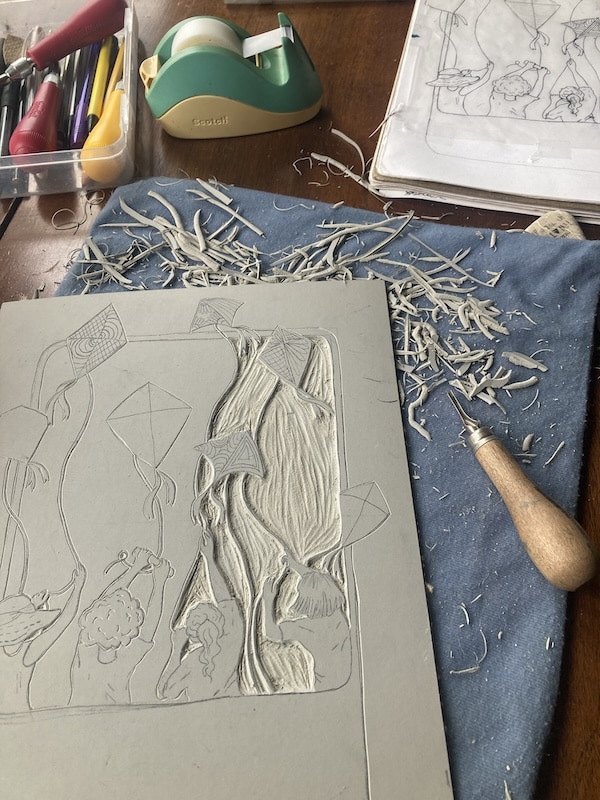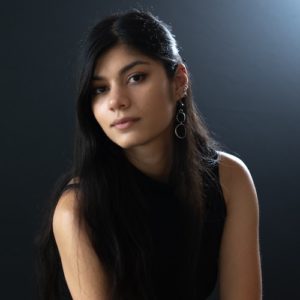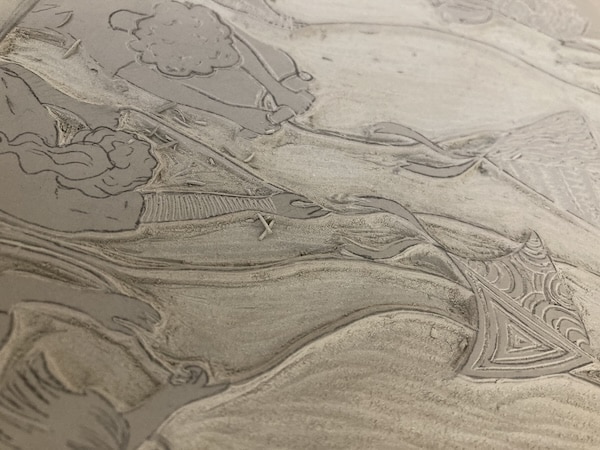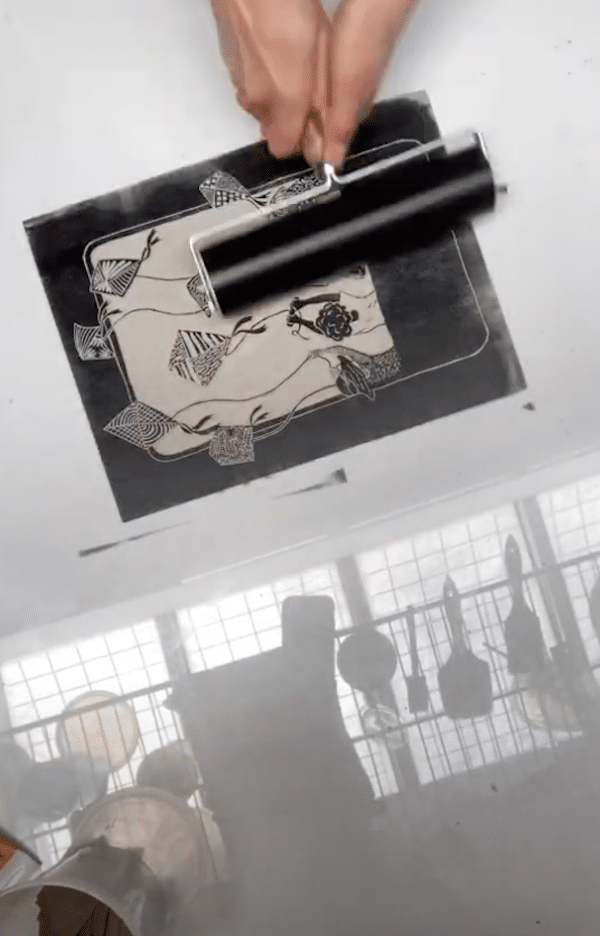
We are excited to invite guest blog writer Arina Sarwari-Stadny to share more about their art making process behind this year’s World Refugee and Immigrant Day Festival poster. Arina is a 2023 ARTogether Mentorship Hub Mentee, WE PLANT OUR FEET IN THE SKY exhibition artist, Pedaling Point participant and an Oakland Style week exhibitor. We are so grateful to have her as a part of our creative and diasporic community here in the Bay Area. See her full bio below!
Linocut Printmaking: Journey and Inspirations
Hello! My name is Arina Sarwari-Stadnyk (she/they) – I am a queer Afghan-Ukrainian printmaker, writer, and climate action fellow residing on Ohlone Huichin land (Oakland). I was introduced to linocut printmaking in 2022 via the Queer Ancestors Project and have been captivated by this medium ever since! In my art, I gravitate towards themes of celebration, diasporic joy, hybrid identity, and cultural memory.
Last month, I had the fun opportunity of designing, carving, and printing an illustration for the 2024 World Refugee and Immigrant Day Festival flyer. In creating this piece, my hope was to capture the joy and connectedness of cultivating a sense of home within our local vibrant, multifaceted diasporic community. I was drawn to the image of flying kites because it reflects this event’s light, uplifting, and festive atmosphere.
The Creative Process
After revising and finalizing my sketch, I used carbon paper to transfer the image onto my carving surface. Traditionally, block printing was done on wood, but I use linoleum because it is more common and easier to carve. Once the image is on the lino, it’s time to dig in!
I used a variety of carving tools to vary line depth and thickness, which creates many fun textures to experiment with. When carving, it’s important to think about negative/positive space– the areas that are carved out create a gap between the lino and the paper, while the areas that are uncarved are what will be printed (it is essentially a large stamp).
Bringing the Print to Life
Next, I took my finished carving to a printmaking studio at Mission Cultural Center for Latino Arts, where I inked and printed it.
I wanted the background color of the print to resemble a sunset, so I did a “rainbow roll”, which is an inking technique that blends colors to produce vibrant gradients. I prefer my pieces to be bright and vibrant, so I use plexiglass to superimpose additional layers of color onto my prints in what is called the “double-drop” technique.
First, I use a roller to ink my linocut in one color (usually dark), lay a piece of paper on top of it (which has been soaked in water and blotted so it can properly absorb the ink) and send it through the press. Once I pull my print, I ink a piece of plexiglass in the rainbow roll color, lay it on top of the print, and send it through the press once again.
The result is a unique effect where the two layers of ink stay separate enough to create a dark image with a bright background while mixing slightly to make new hues beyond what the original ink offers. If I am interested in softer, gentler colors, I use a technique called “ghost printing”, where I re-print my lino or plexiglass without re-inking it.
The Beauty of Manual Printmaking
What I love about manual printmaking is that no two prints will turn out exactly the same. It is a process that lends itself to endless experimentation, which expands traditional understandings of what can and can’t be done with this medium. Certainly, it involves plenty of trial and error— the paper not blotted properly, the press too tight or loose, over-inking or under-inking, registration (alignment) being off-kilter, etc. Yet once the myriad of factors are finally in harmony, the results are crisp, saturated, and vibrant!
I am deeply grateful to have had the chance to contribute to the World Refugee and Immigrant Day Festival through my art and to share my process with others! A huge thank you to Sabina Kariat for helping me brainstorm, organizing logistics, and generally being a source of support throughout this endeavor.
For those curious about my other prints (plus occasional crafts and doodles), check out my art Instagram: @absurdistan__ (Link)
Join us for World Refugee and Immigrant day 2024!
About Arina:

Arina Sarwari-Stadnyk (she/they) is a queer Afghan-Ukrainian writer and printmaker on occupied Ohlone Lisjan land. She holds a BA in English and Creative Writing from UC Berkeley and is preparing to start an MFA in Creative Writing at SFSU this fall. Arina aspires to create work that reaches through the fabric of history to document the ways in which bodies and landscapes continue to reciprocally haunt one another. Her drawings, linocut prints, poems, and lyrical essays are concerned with the symbiosis of diasporic memory and intergenerational silence. In her free time, Arina enjoys skating, getting lost in bookstores, collecting strange trinkets, petting stray cats, and generally wreaking havoc. | Photo Credit: Sarah Dawson McClean





